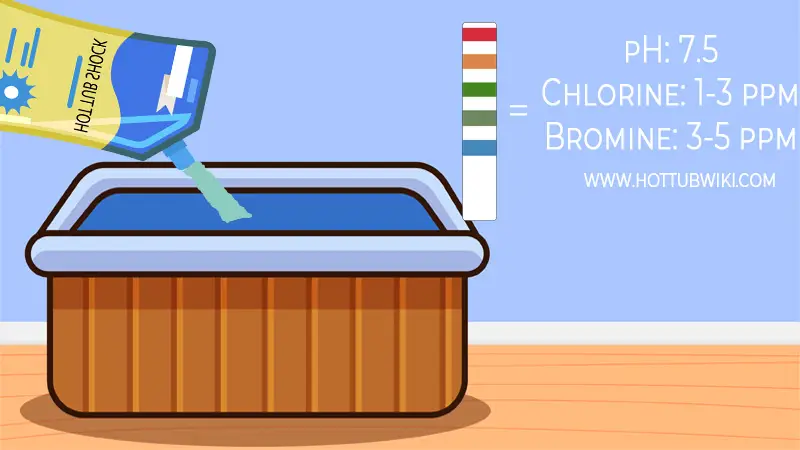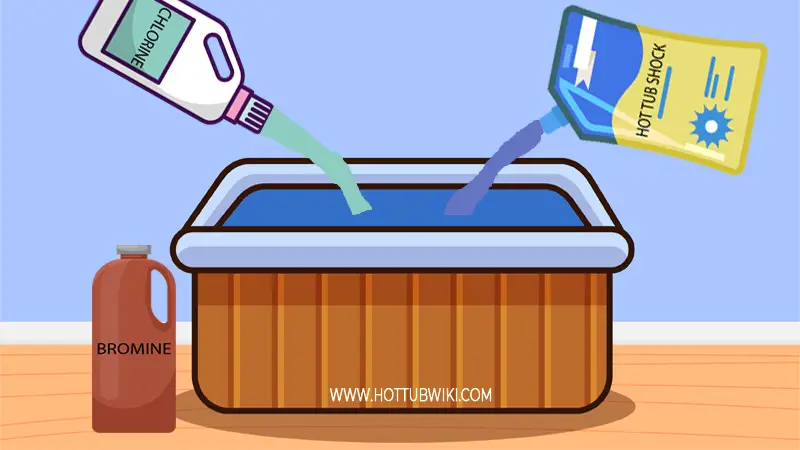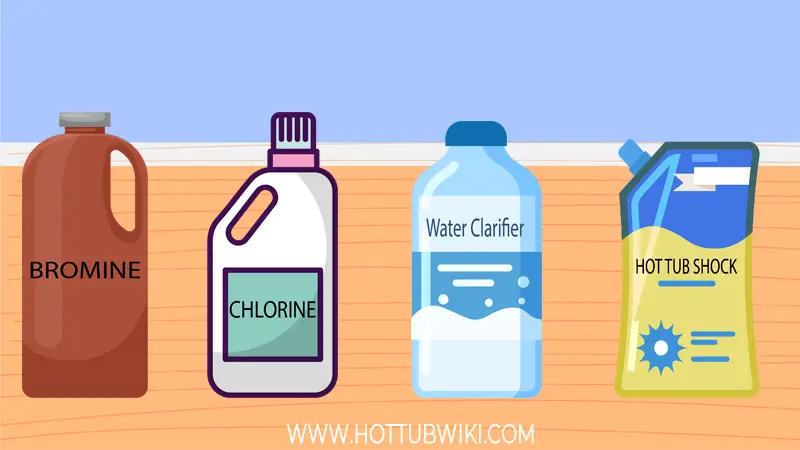If you just bought a hot tub, then you probably heard about spa shock. Spa shock helps you to clean spa water, but do you have to shock the hot tub after refilling?
You don’t need to shock your hot tub after refilling it because hot tub shock is mainly an oxidizer that reactivates the sanitizers being used in the water. Since you haven’t added any sanitizer to the water, there is no chemical or sanitizer to shock.
There’s more to know about this. We will teach you to know exactly when to add spa shock, and how to do it. Check it out.
Should You Shock the Spa Before the First Use?
If it’s the first use after a long time of not using the hot tub, then you should shock the hot tub before using it. If this is the first time you ever used a hot tub, then you don’t need to shock it.
As long as the water is clear, and you have added the needed sanitizers, you don’t have to shock the hot tub for the first time ever.
The spa shock will re-activate the chlorine or bromine in your hot tub, and get rid of the contaminants, cloud water, and dirt that has been accumulated from using the hot tub. But, if the spa wasn’t used, and the water is clean, then there’s no need to shock the hot tub.
Do You Need to Shock the Hot Tub After Each Use?
You should not shock the hot tub after each use because it will lead to a very high level of chlorine and un-balanced pH in the water. Hot tub water with an un-balanced pH and high chlorine level will damage the hot tub. The levels of chemicals can be hard and damage your hot tub plumbing too.
Shocking your hot tub should only be done when the chlorine levels are very low and when there is too much scum or bacteria in the water. It will take days after adding sanitizer to the water for the sanitizer to get depleted or used up to a point when you have to shock the water.
Chlorine for instance lasts in a hot tub between 3 days during very heavy use and 7 days during regular use. Heavy use here means constant use by a large number of people for days.
Bromine sanitizer which is a bit less potent than chlorine lasts longer in a hot tub. Bromine can last up to 8 days in a hot tub and still remain active. So take it easy on the hot tub shock.
After Re-filling: Should You Add Sanitizers or Shock First?
After re-filling the hot tub, you should add sanitizers only. You don’t need to shock the spa if you just refilled the hot tub water. You should shock the spa every week, or after heavy use.
You shouldn’t add chlorine and shock at the same time. Shock is chlorine but in a high dose. If you add the shock and the chlorine at the same time, you would raise the chlorine levels so much that it would make the entire process useless.
If you want to balance the water chemistry of your hot tub, you should first shock the hot tub then add chlorine. After shocking, wait for the chlorine levels to drop then add chlorine.
Can You Shock a Hot Tub Without Adding Sanitizers?
There are two types of spa shock, chlorine (sodium dichlor) and non-chlorine shock (potassium monopersulfate). Whenever you use chlorine or non-chlorine shock it doesn’t matter, both of them do the same job. Spa shock restores the efficiency of the spa sanitizers and breaks down the hot tub dirt.
You can shock the hot tub without adding sanitizers, but it’s not recommended. The spa shock will get rid of the organic waste contaminants and dirt, but it won’t keep your hot tub water safe for too long. Once the spa shock effect goes away, the hot tub will get dirty very fast.
Plus, spa shock raises the alkalinity levels. Having high alkalinity also means you will have un-balanced pH. The sanitizers will keep the pH and alkalinity levels balanced. But, if you don’t have sanitizers then the water chemistry will get unbalanced very fast.
When Should You Shock Your Hot Tub?
You should shock your hot tub once per week during heavy use or once in two weeks during regular use. You should also shock the hot tub if the sanitizer level is low.
You need to shock the water when the water is getting dirty and the chlorine or bromine level is very low. This is the best time your hot tub will benefit from the shock. This means you don’t need to shock your hot tub when you refill it.
Alternatively, you can tell when you need to shock your hot tub by testing the water regularly. Whenever you discover that the chlorine or bromine level in the hot tub is low, you can shock the hot tub to reactivate the sanitizer.
The ideal chlorine level for a hot tub is between 1ppm and 3ppm. If the chlorine test result shows that you have less than 1ppm of chlorine in the water, you should shock the water.
For bromine, the ideal level is between 3ppm and 5ppm. If your bromine level falls below 3ppm, you should shock the water too.
Shocking the hot tub water should also be done whenever there is green water in the hot tub. Green water is hot tub water filled with hot tub scum, bacteria, and even algae.
How Long After You Shock a Hot Tub Can You Go in?
You can go into your hot tub after shocking it when you have tested the water and the chlorine level is below 3 parts per million (or 3 PPM) on your test strip. You can also use the hot tub after shocking it when the pH level of the water is below 7.8 on the pH scale.
After shocking your hot tub, the chlorine level can rise to 5PPM in the water. So it’s not right to get in your hot tub immediately after shocking. You should wait till the chlorine level is below 3PPM. This is the ideal chlorine levels for hot tubs.
How Does Hot Tub Shock Work?
Hot tub shock is a chemical that works by reactivating the hot tub sanitizer that is being used in the hot tub. The shock increases the sanitizer level in the hot tub and destroys hot tub scum and other contaminants in the water.
A misconception about hot tub shock is that when it is added to the water, it fights and kills all the hot tub scum and germs. Well, it does but not the way you think.
When you shock a spa, the shock you added is both an oxidizer and a sanitizer. It reactivates the sanitizer in the water and adds to it. This means that the sanitizer can battle the contaminants better. Think of it as the chlorine in your hot tub calling for backup.
So it’s not the shock that cleans and kills. It’s the sanitizer, only that it is now more powerful and in more quantity than before the shock was added.
What Chemicals Should You Add After Refilling The Hot Tub?
You should add a sanitizer, either bromine or chlorine to the hot tub after refilling it. Then you should test for the properties of the water and adjust it as needed with the right chemicals.
After refilling your hot tub with fresh water, the first chemical to add is a hot tub sanitizer of your choice. You can pick chlorine, bromine, or any other alternative. The sanitizer will remove all impurities in the hot tub and keep the water clean for the first few days.
Chlorine is the most common hot tub sanitizer. Most hot tub users prefer to use chlorine as their sanitizer because it is more potent than any other sanitizer.
Chlorine is very effective in ridding your hot tub water of any contaminant, bacteria, or germs and it dissolves fast in the water. A major disadvantage of chlorine is the strong offensive odor of chloramines that it produces after usage.
Bromine is another popular choice for hot tub users that have very sensitive skin. Bromine is much gentler than chlorine but it is more expensive which is a disadvantage.
Other common choices of hot tub sanitizers include biguanide, minerals, UV (ultraviolet) light and some hot tubs use salt through the salt cell chlorinator.
What Else?
After adding the needed sanitizer, you should adjust the properties of the water by adding the needed chemicals to make the water ideal for soaking in. You should check the water pH level, calcium hardness level, total alkalinity, and iron levels in the water.
If any of these is below or above the ideal level for a hot tub, you should adjust it with the needed chemicals. You can use hot tub test strips to test for all these.
The ideal pH level for a hot tub is between 7.2 and 7.8 on the pH scale with 7.5 being the sweet spot. If the pH level is high or low, you can correct it by adding pH decreaser or pH increaser to the water.
The total alkalinity level should be between 80ppm and 120ppm. If the total alkalinity is off, you should correct it.
The ideal calcium hardness level for a hot tub is between 80ppm and 220 ppm, with 180ppm being the sweet spot. If the calcium hardness level of your hot tub water is off, the water will start to foam.
Related Read: How To Shock a Salt Water Hot Tub?
Is Hose Water Chlorinated?
The water provided by the city is chlorinated. That’s because the city adds chlorine to the water to keep it clean. But, the chlorine levels as soo low that you still need to add chlorine.
The level of chlorine in your hose water isn’t high enough to protect your hot tub from dirt. And, it won’t re-activate the sanitizers. That’s why spa shock is necessary.
Final Words
Overall, shocking your hot tub isn’t a practice to make a habit of. You only need to shock the hot tub whenever the sanitizer level is low or below the recommended level (1ppm for chlorine and 3ppm for bromine).
As a tip, always test the pH level of your hot tub before you add hot tub shock to the water so you don’t alter the pH levels.



